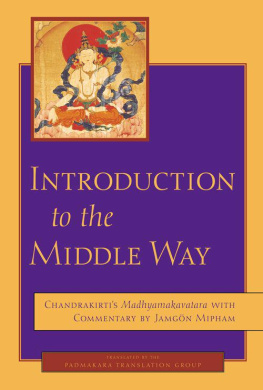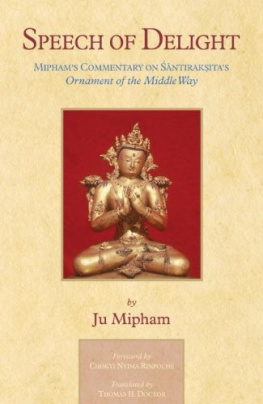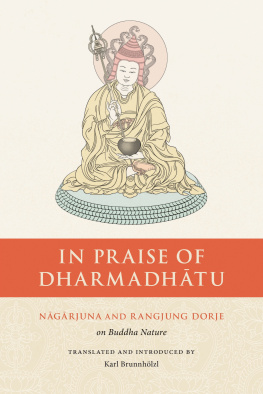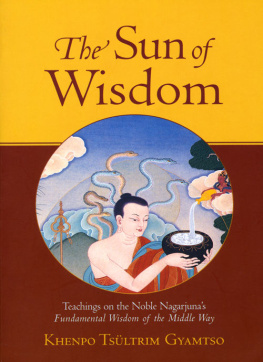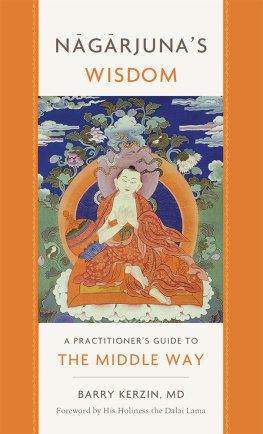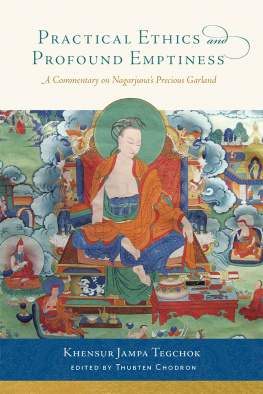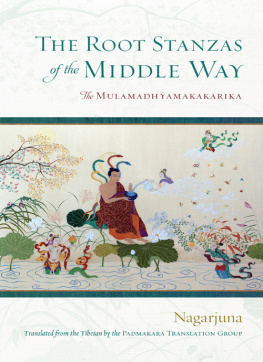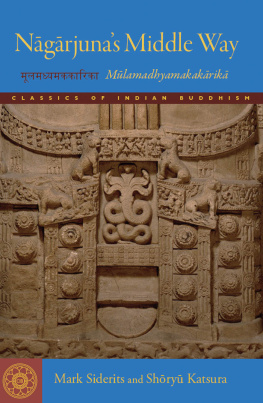
ORNAMENT OF REASON

Ornament of Reason
THE GREAT COMMENTARY TO NGRJUNAS
Root of the Middle Way
by Mabja Jangchub Tsndr
Translated by the Dharmachakra
Translation Committee
SNOW LION PUBLICATIONS
ITHACA, NEW YORK
Snow Lion Publications
P.O. Box 6483 Ithaca,
NY 14851 USA
(607) 273-8519
www.snowlionpub.com
Copyright 2011 Dharmachakra Translation Committee
All rights reserved. No part of this book may be reproduced without prior written permission from the publisher.
Printed in USA on acid-free recycled paper.
ISBN-13 978-1-55939-368-3
ISBN-10 1-55939-368-8
Library of Congress Cataloging-in-Publication Data
Rma-bya Byang-chub Brtson-grus, d. 1185.
[Dbu ma rtsa ba shes rab kyi grel pa thad pai rgyan. English]
Ornament of reason : the great commentary to Ngrjunas Root of the middle way / by Mabja Jangchub Tsndr; translated by the Dharmachakra Translation Committee.
p. cm.
Includes translations from Tibetan.
Includes bibliographical references and index.
ISBN-13: 978-1-55939-368-3 (alk. paper)
ISBN-10: 1-55939-368-8 (alk. paper)
1. Ngrjuna, 2nd cent. Madhyamakakrik. 2. Mdhyamika (Buddhism)Early works to 1800. I. Ngrjuna, 2nd cent. Madhyamakakrik. English. II. Dharmachakra Translation Committee. III. Title.
BQ7479.8.N344M333713 2011
294.385dc22
2010037413
The print edition of this book was designed and typeset by Gopa & Ted2, Inc.
Visual outline on pp. 53375 created for the Tsadra Foundation
by Rafael Ortet.

Foreword
I AM OFTEN reminded of the great kindness of the scholars and translators of the past who translated a vast array of Buddhist literature into Tibetan. Through their persistent efforts, working in small teams, they made books available to Tibetans that allowed a deep understanding of the Buddhas teachings to take root in Tibet. It was this understanding that later found expression in the many books composed by Tibetan authors. Therefore, it gives me great pleasure to know that there are groups of experienced translators today, similar to those of the past, such as the Dharmachakra Translation Committee, who are working steadily to translate Buddhist books from Tibetan into English and other Western languages. Undoubtedly these will make an invaluable contribution to a deep and lasting understanding of the Buddhist tradition.
The revered Indian master Ngrjuna was extremely kind, like a second Buddha. He was a scholar of high distinction, who was renowned for his spiritual realization. The Buddha made a prophecy in the Lankavatara Sutra about his coming and what he would do to preserve and propagate Buddhism. He restored the declining Mahayana tradition and his six works on the Madhyamika view laid the basis for the Madhyamika School. Even to this day we regard Arya Ngrjuna as the final authority concerning the Madhyamika point of view.
Ngrjunas Root of the Middle Way presents a clear, firm philosophical thesis with respect to things lacking true existence. It argues that just as sentient beings are devoid of innate existence, so are all Buddhas, the cycle of existence, and the tranquility of nirvana. Such assertions are a great source of inspiration, for they suggest that each of us has the opportunity to scale the greatest spiritual heights, provided we tread the right path.
I am pleased to know that great care has been taken in preparing this translation along with the early Tibetan commentator Mabja Jangchub Tsndrs explanation of the Root of the Middle Way. I have no doubt that readers interested in the development of the Madhyamika view will derive great benefit from this work. I congratulate all who have participated in this translation and offer my prayers that the good you have done will make a far-reaching contribution to peace and enlightenment in the world.

11 September 2008
Translators Introduction
IN THE Root of the Middle Way, Ngrjuna presents a magical method of reasoning, inviting everyone who encounters these lucid and fearless contemplations to follow him on a journey to the heart of transcendent insight. Inspired by the Buddhas teachings on profound emptiness in the Prajpramit Stras, Ngrjuna sets out to probe what appears to be the most fundamental facts of the world, challenging us to question even our most deeply ingrained ideas and what seem to be self-evident facts.
In a series of unassuming and penetrating investigations, he asks basic questions. What does it mean for something to occur, for something to take place? What is meant by going or by coming? What is an action and who or what might perform such an act? Does the eye see? Does fire burn fuel? What is an example of being right? What does it mean to be wrong? What is confinement? What is freedom? Ngrjuna extends an invitation to open-minded and unprejudiced inquiry, and from his reader he asks for nothing more and nothing less than sincere and honest answers. Yet where are our answers? Once we begin to follow Ngrjunas clear and direct steps, the gateway to the inconceivable emerges. Perhaps unexpectedly.
In the nearly two thousand years since these verses first appeared, the Root of the Middle Way (or M lamadhyamaka-kriks as they are known in their original Sanskrit) has continued to provoke and inspire, and its place among our worlds great literary treasures cannot be questioned. First in Asia, and more recently throughout the world, these verses have continued to serve as a vexing nexus of philosophical inquiry, just as they have emerged as a timeless source of liberating insights.
The present work contains Ngrjunas verses on the Middle Way (Skt. Madhyamaka, Tib. dBu ma), accompanied by Mabja Jangchub Tsndrs famed commentary, the Ornament of Reason. We are delighted to present here an English translation of Ngrjunas classic treatise in the company of Mabjas dynamic explanations.
Technical Notes and Acknowledgments
Our translation of the Root of the Middle Way is based on the Tibetan version contained in the Derge (sDe dge) edition of the Tibetan Tripitaka, and for the Ornament of Reason we have relied on the woodblock prints prepared under the auspices of the sixteenth Gyalwang Karmapa. Particularly challenging points were discussed with the kind and expert help of Khenpo Sherab Sangpo, Khenpo Jampa Donden, professor Tom Tillemans, professor John Dunne, and Dr. Mattia Salvini. We are most grateful to them all. The entire production of the manuscript for this book was sponsored by a grant from the Tsadra Foundation. We sincerely thank the Foundation for their generous and inspiring support.
Personally, I wish to express my gratitude to Tulku Chkyi Nyima Rinpoche, himself known as an emanation of Ngrjuna, for his clear and profound Madhyamaka teaching, and to Khenpo Chga, Lobpn Yeshe Trinley, Khenpo Sherab ser, Tulku Sang-ngag Tendzin, and Khenpo Sherab Sangpo (here mentioned in the order that I was able to learn from them at Ka-Nying Shedrub Ling Monastery) with whom I have had the fortune of studying a few Indian Madhyamaka treatises, including the


